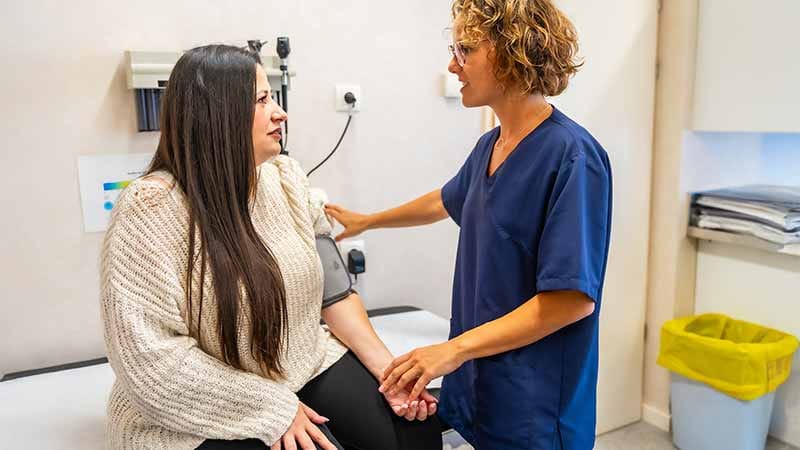Heart failure is often diagnosed after patients have already lost much of their function and quality of life, but emerging tools that noninvasively measure heart function may offer new ways to catch the disease sooner.
A recent study published in JACC: Advances tested one such tool, the FDA-cleared Vivio System, which estimates left ventricular end-diastolic pressure (LVEDP), in more than 2000 patients at high risk for heart failure who were seen at three primary care centers.
Nearly 40% of these patients, all of whom had diabetes, chronic kidney disease, or suspected heart failure, had elevated LVDEP, an indicator of heart failure. More than two thirds also reported symptoms, limitations, or impaired quality of life. However, none had a prior diagnosis.
Many heart failure diagnoses occur in the emergency room or inpatient setting, according to lead study author Omar Cantu-Martinez, MD, from Healthcare Institute for Innovations in Quality, University of Missouri-Kansas City, and Saint Luke’s Mid America Heart Institute, Kansas City, Missouri.
“Waiting until patients present with significant symptoms leads to worse outcomes and misses the opportunity for earlier detection and treatment that could prevent these hospitalizations,” he said in an interview.
The Diagnostic Challenge in Primary Care
Early signs of heart failure are easy to miss, according to Gregg Fonarow, MD, an American Heart Association (AHA) national volunteer expert and director of the Ahmanson-UCLA Cardiomyopathy Center.
“This may be especially true for older adults or those with overlapping chronic conditions,” Fonarow, who was not involved in the study, told Medscape Medical News. “Mild exertional intolerance or vague malaise may be dismissed as aging or deconditioning.”
 Ambar Kulshreshtha, MD
Ambar Kulshreshtha, MD
Symptoms such as fatigue, dyspnea, and edema may also be attributed to chronic obstructive pulmonary disease, obesity, anemia, kidney disease, or depression, noted Ambar Kulshreshtha, MD, a family physician and an associate professor in the Department of Family and Preventive Medicine at Emory University School of Medicine in Atlanta.
“The biggest issue in detecting heart failure early is that the symptoms can be very nonspecific,” Kulshreshtha said. He noted that referral to cardiology typically happens when an individual presents with dyspnea on exertion, abnormal ECG results or elevated B-type natriuretic peptide (BNP) levels.
Short clinic visits, which make it hard to explore nuanced symptoms or perform thorough assessments, and fragmented care also complicate diagnosis, according to Fonarow.
“Further care can be fragmented when specialists treat individual conditions without synthesizing the whole clinical practice,” he said. “The primary care physician may believe if the patient had heart failure, it would have been recognized by one of the specialists involved in the patient’s care, even though it was not.”
Filling a Gap in Current Guidelines
LVEDP measurement has traditionally required cardiac catheterization, limiting its use to advanced or unconfirmed cases.
Current American College of Cardiology guidelines recommend confirmatory testing such as a BNP test and echocardiography once heart failure is suspected. Cardiac catheterization may also be required in some advanced or unconfirmed cases.
“Until now, tools that could noninvasively measure LVEDP — the gold-standard invasive hemodynamic measure for heart failure detection — were not available,” Cantu-Martinez said.
Noninvasive LVEDP screening may give primary care physicians a way to identify possible heart failure in patients who they may not have suspected to have the condition.
“A positive screen could prompt confirmatory testing and earlier referral to a heart failure specialist, rather than waiting for disease progression,” Cantu-Martinez said. “The Vivio System can detect estimated elevated LVEDP with 80% sensitivity and 83% specificity.”
In the study, one third of patients with elevated LVEDP were asymptomatic, while two thirds already reported symptoms on the Kansas City Cardiomyopathy Questionnaire (KCCQ-12). Twenty-six percent of patients with elevated LVEDP had severe symptoms consistent with NYHA class II or higher.
 Gregg Fonarow, MD
Gregg Fonarow, MD
“Noninvasive devices using a brachial blood pressure cuff and single-lead ECG to estimate LVEDP in minutes offer a practical alternative for earlier screening,” Fonarow said.
Other tools, such as AI-enhanced ECGs, are also being studied as possible ways to flag patients at risk earlier.
Kulshreshtha said tools like these could help fill gaps in primary care.
“The current guidelines offer a structured framework for evaluating heart failure in primary care,” he said. “However, there is a need for more precise diagnostic algorithms, including clear thresholds for tests, to detect and triage heart failure earlier.”
Even when heart failure is identified, many patients still fall through the cracks after hospitalization. Nearly 20% of patients are readmitted within 30 days of discharge, and many patients do not receive all four guideline-directed therapies, including an angiotensin receptor-neprilysin inhibitor, a beta-blocker, a mineralocorticoid receptor antagonist, and a SGLT2 inhibitor.
“The earlier guideline-directed medical therapy is started, the better the outcomes,” Fonarow said.
The AHA recently launched a virtual program that provides ongoing cardiometabolic and heart failure management at home. Participating hospitals can refer patients before discharge, and once enrolled, patients receive remote monitoring devices, vital-sign tracking, and 24/7 clinical support. The purpose is to reduce readmissions and extend evidence-based care to patients in their homes, especially those in underserved communities.
Feasibility in Primary Care
Some physicians may worry about adding yet another test to already overburdened clinic visits, but Cantu-Martinez said the Vivio System is designed for efficiency.
“Heart failure screening with the Vivio System and the KCCQ-12 takes
Kulshreshtha agreed that integration is possible but emphasized the need for further validation.
“With proper training and education, noninvasive LVEDP has the potential to be integrated into primary care practices,” Kulshreshtha said. “However, further studies are needed in primary care to validate and assess the effectiveness of this approach, and also to develop reimbursement models that support these novel diagnostics.”
The study also found that women were more likely to have elevated LVEDP than men.
“The underdiagnosis and delayed recognition of heart disease in women are well-documented,” Cantu-Martinez said. “Our finding of a higher proportion of women with elevated LVEDP underscores the importance of maintaining a high index of suspicion for heart failure in women.”
He said combining LVEDP testing with the KCCQ-12 gives patients a way to articulate symptoms and functional limitations that might otherwise go unrecognized.
“These approaches can support earlier detection and treatment of heart failure across all patients, regardless of sex or race, and may help reduce sex-based biases in diagnosis and care,” he said.
Experts agree that earlier detection of heart failure has the potential to lower hospitalization and mortality rates.
“Our goal is to catch heart failure before it catches our patients off guard,” Cantu-Martinez said.
Fonarow reported consulting for Abbott, Amgen, AstraZeneca, Bayer, Boehringer Ingelheim, Cytokinetics, Eli Lilly, Johnson & Johnson, Medtronic, Merck, Novartis, and Pfizer. Cantu-Martinez and Kulshreshtha reported no conflicts of interest.
Lara Salahi is a health journalist based in Boston.
